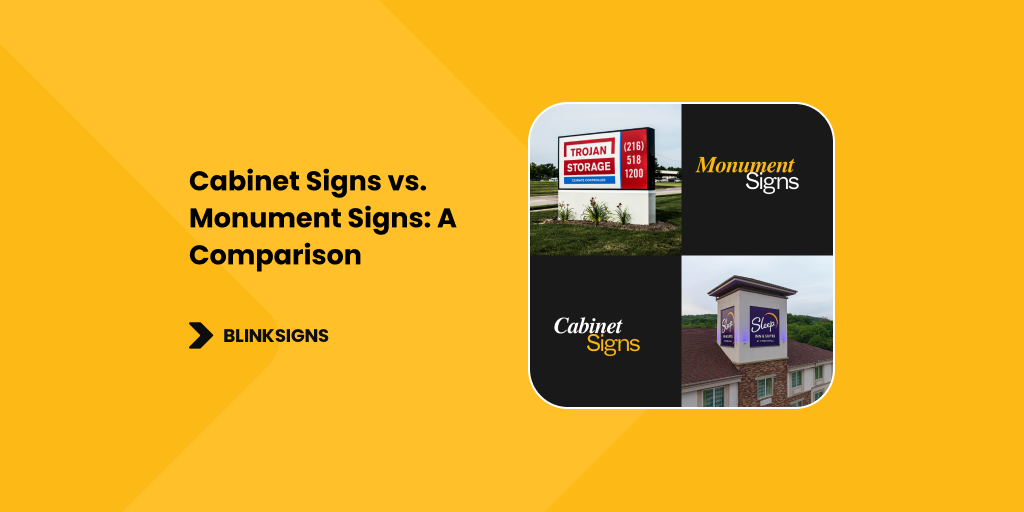
Cabinet Signs vs Monument Signs: A Comprehensive Comparison
Cabinet signs and monument signs are among the most widely used signage solutions. Cabinet signs are favored for their bold visibility, particularly in high-traffic areas, while monument signs are chosen for their timeless aesthetics and ability to establish a strong presence. Each type offers unique advantages tailored to specific business needs, making signage a strategic decision that impacts visibility, branding, and customer perception. In this article, We will define which signage solution is good for your business. Also, you will review the detailed difference between Cabinet signs vs monument signs.
What are Cabinet Signs?
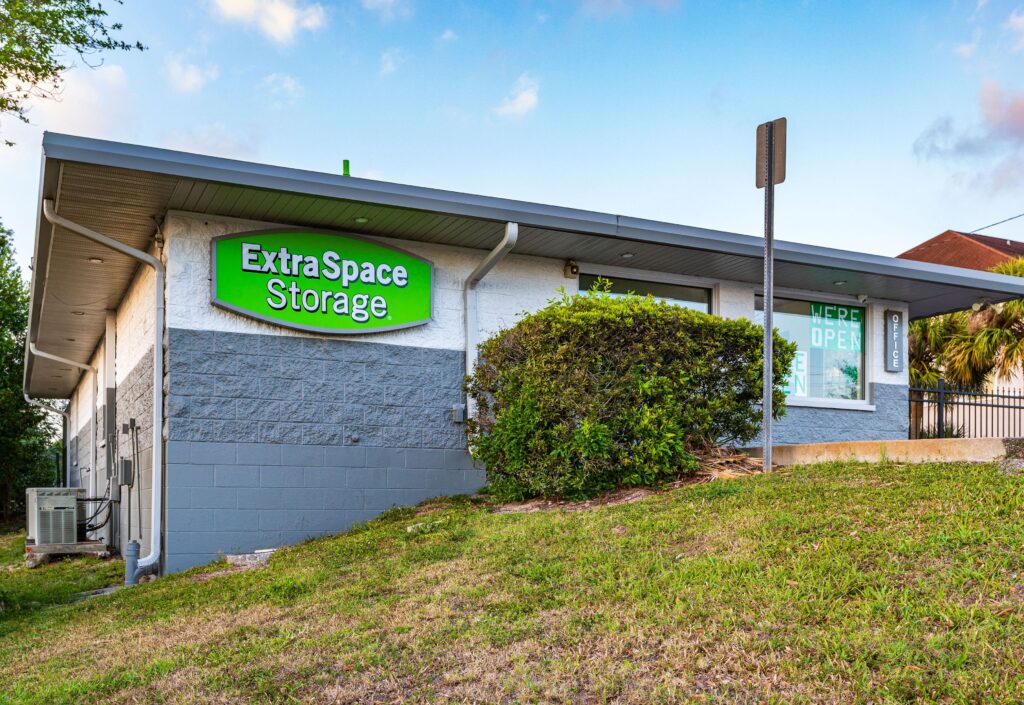
Cabinet Sign of Extra Space Storage by Blinksigns
Definition and Purpose
Cabinet or box signs are enclosed signs designed to provide optimal visibility. They feature illuminated or non-illuminated designs and are encased within a box-like structure, often constructed with materials such as aluminum or acrylic. Businesses use these signs to ensure their brand message is visible, even from a distance.
Types of Cabinet Signs
Single-Face vs. Double-Face Signs: Single-face signs are mounted on walls, while double-face variants are freestanding, making them visible from both directions.
Illuminated Cabinet Signs: Options include LED and neon lighting, which provide enhanced visibility at night or in low-light conditions.
Wall-Mounted and Pole-Mounted Variants: These designs cater to specific placement needs, such as storefronts or roadside advertising.
Advantages of Cabinet Signs
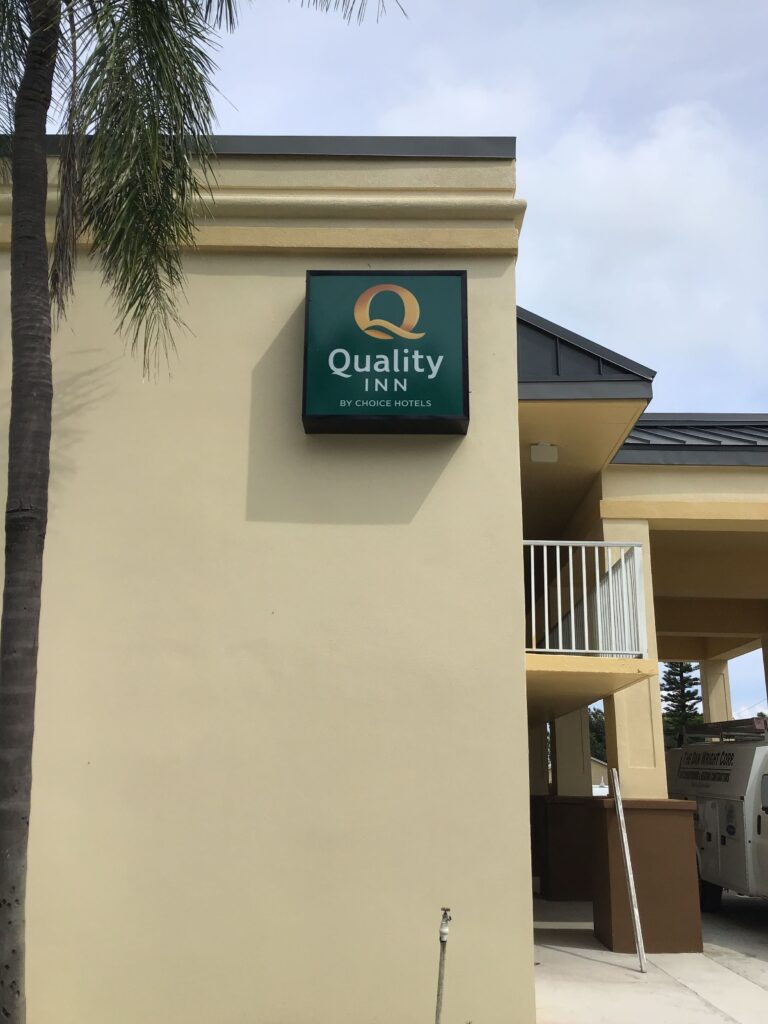
Cabinet Sign Quality Inn hotels by Blinksigns
Cabinet signs stand out for their adaptability, durability, and cost-effectiveness. They are highly customizable, allowing businesses to incorporate brand colors, logos, and unique design elements. Their robust construction ensures longevity, even in harsh weather conditions, while their illumination options provide round-the-clock visibility.
Common Locations for Cabinet Signs
These signs are prominently used in shopping malls, gas stations, retail outlets, and along busy highways. Their ability to attract attention makes them a preferred choice for businesses in urban and suburban areas.
What are Monument Signs?
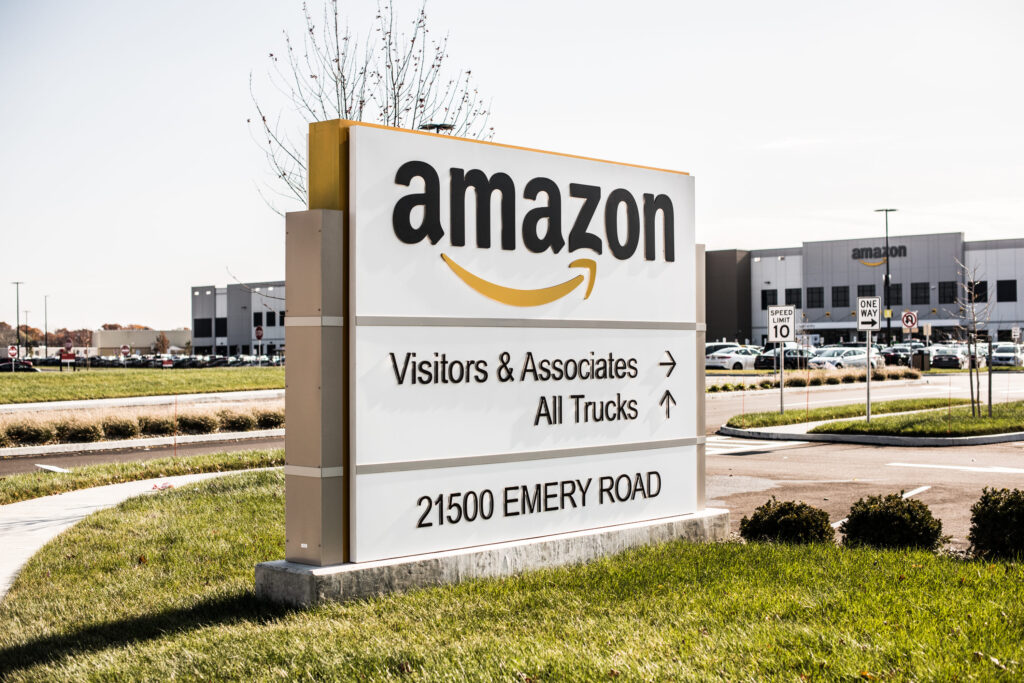
Monument Sign Amazon by Blinksigns
Monument signs are ground-level structures that convey a sense of permanence and professionalism. Constructed from durable materials such as stone, brick, or composite materials, they serve as a landmark for businesses, offering clear visibility while blending seamlessly with their surroundings.
Types of Monument Signs
Masonry-Based vs. Foam Core Construction: Masonry signs provide a traditional look, while foam core options are lightweight yet durable.
Illuminated vs. Non-Illuminated Signs: Illuminated versions enhance visibility during the evening, whereas non-illuminated designs focus on aesthetics.
Multi-Tenant and Directional Signs: Ideal for business parks and commercial complexes, these signs offer space for multiple tenants or directional information.
Advantages of Monument Signs
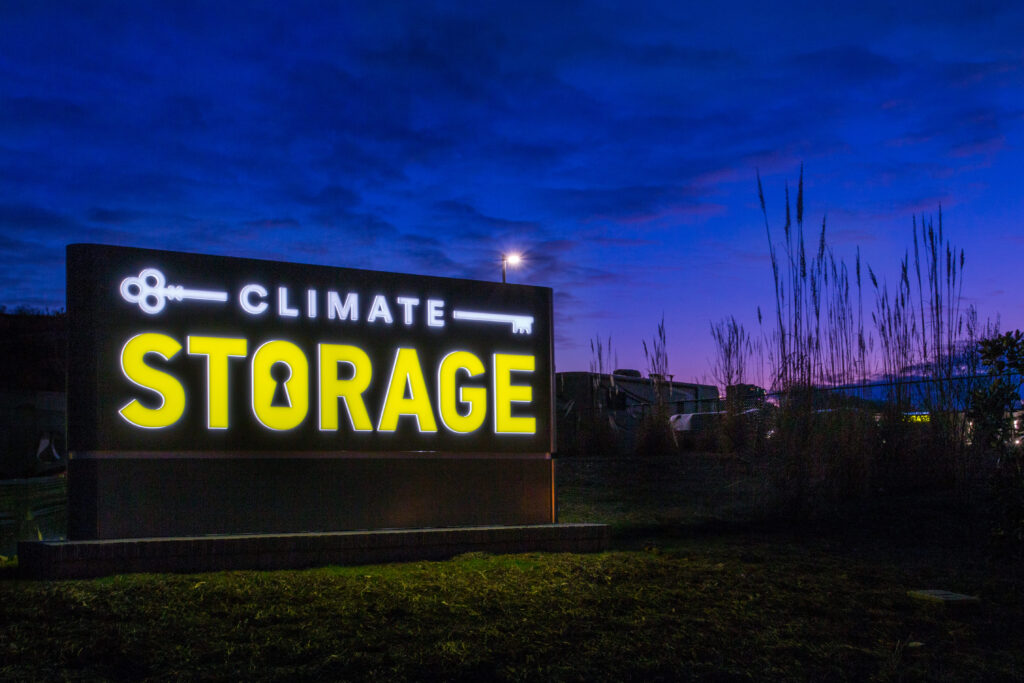
Monument Sign for Climate Storage by Blinksigns
Monument signs deliver unmatched aesthetic appeal and durability. They project a professional image, enhancing customers’ trust and credibility. Their robust construction ensures longevity, while their customizable designs align with specific branding needs.
Common Locations for Monument Signs
Monument signs are typically placed in corporate parks, healthcare facilities, schools, and residential developments, where long-term branding and navigation are essential.
Key Differences Between Cabinet and Monument Signs
This table helps clarify the functional and aesthetic differences between cabinet and monument signs, enabling businesses to choose based on their branding and operational needs.
| Aspect | Cabinet Signs | Monument Signs |
| Definition | Box-like signs with an enclosed cabinet design are often illuminated. | Ground-level signs with a solid base offer a more permanent appearance. |
| Design and Materials | Made of materials like aluminum, acrylic, and polycarbonate. | Constructed using durable materials such as brick, stone, concrete, or high-density foam. |
| Illumination | Typically illuminated using LED or neon lighting for visibility, day and night. | Depending on the setting, it may include backlighting, spotlighting, or no illumination. |
| Size and Placement | Mounted on walls or poles for elevated visibility. | Placed directly on the ground, often at entrances to businesses or complexes. |
| Aesthetic Appeal | Modern and bold, it is designed for high visibility and dynamic branding. | Elegant and professional, it blends seamlessly with architectural designs. |
| Durability | Highly durable but may require frequent maintenance due to exposure to elements. | Extremely durable, built to withstand harsh weather and provide long-term use. |
| Cost | Lower initial cost, especially for non-illuminated versions. | Higher initial investment due to materials and construction complexity. |
| Target Audience | Retail stores, gas stations, and entertainment venues seek bold, eye-catching signs. | Corporate offices, healthcare facilities, and real estate developments need professional, timeless signage. |
| Customization Options | Allows vibrant graphics, bold colors, and dynamic designs. | Supports a clean, sophisticated look with options for engraving, masonry, or metal accents. |
| Compliance Requirements | It may require specific permits for height and illumination. | Often subject to stricter zoning and placement regulations. |
| Maintenance Needs | Regular checks for lighting and structural components are essential. | Minimal maintenance is required, along with occasional cleaning and inspections. |
| Visibility | Effective for attracting attention from a distance, especially on busy roads. | Designed for local visibility, creating a strong impression at business entrances. |
| Longevity | Moderate lifespan, with potential for lighting replacements over time. | Long-lasting due to robust materials and sturdy construction. |
| Use Cases | It is ideal for fast-paced environments like retail, dining, and gas stations. | Best suited for upscale businesses, schools, and residential developments. |
Compliance and Regulatory Requirements
Permitting Process
Signage permits are essential to ensure compliance with local zoning ordinances, building codes, and safety standards. Applications typically require site plans, material specifications, and elevation drawings to meet regulatory criteria.
Height, Setback, and Size Restrictions
Local zoning regulations dictate the allowable height, setback, and size of signs to maintain community standards and prevent visual clutter. These restrictions vary based on location, with commercial zones often allowing larger signage than residential areas.
ADA Compliance and Accessibility
Both cabinet and monument signs must adhere to ADA requirements, including using Braille, non-glare finishes, and appropriate height placement to ensure accessibility for all individuals.
Environmental Regulations
Illuminated signs must comply with light pollution ordinances and eco-friendly practices. Businesses are encouraged to use energy-efficient lighting and sustainable materials to meet these standards.
Design Considerations for Cabinet and Monument Signs
Customization Options
Cabinet signs offer vibrant customization opportunities, including bold colors, dynamic fonts, and illuminated graphics. Monument signs emphasize sophisticated designs that integrate seamlessly with their surroundings, often featuring textured finishes and elegant typography.
Branding Impact
Effective signage strengthens brand identity and customer recognition. Cabinet signs are designed to grab attention and promote bold branding, while monument signs convey professionalism and stability, aligning with premium brand values.
Lighting and Visibility
Illumination plays a crucial role in enhancing visibility. Cabinet signs often use LED or backlit lighting, ensuring high visibility at night. Monument signs can include halo lighting or subtle ground illumination to create a polished effect.
Placement Strategies
Strategic placement maximizes the impact of signage. Cabinet signs are typically positioned for high visibility near roads or atop buildings, while monument signs are placed at entrances or along pathways to guide customers effectively.
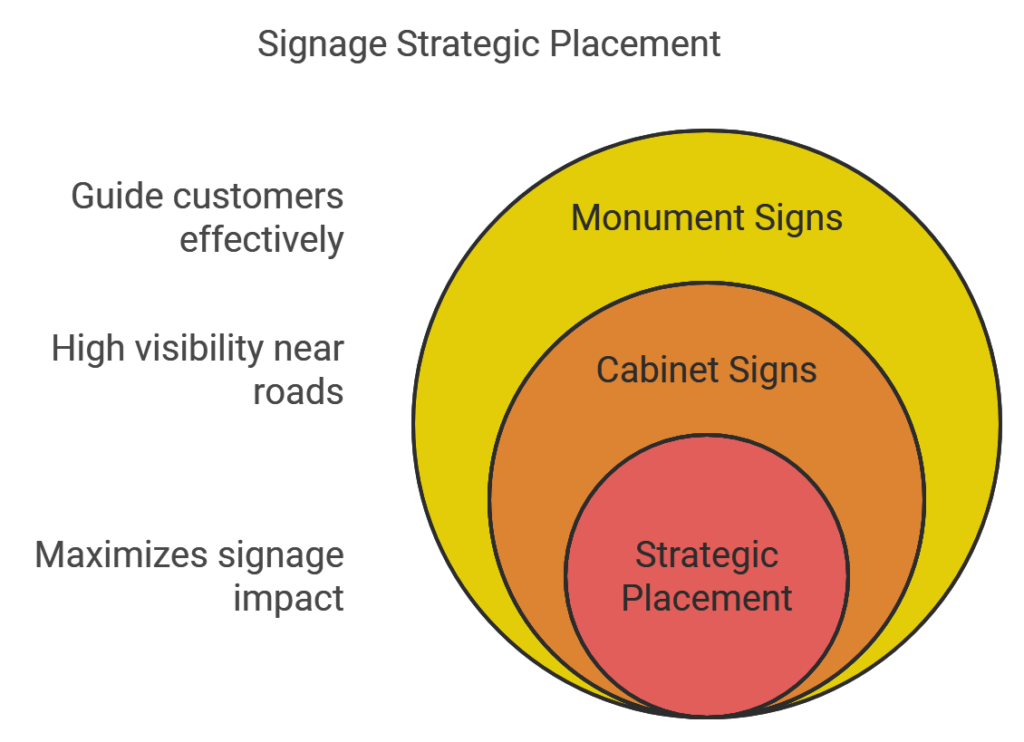
Signage Strategic Placements
Cost Analysis: Cabinet Signs vs Monument Signs
Initial Investment
The initial cost for cabinet signs varies based on materials, size, and lighting options. These signs often require lower upfront expenses, particularly for non-illuminated variants. Monument signs, however, involve higher initial costs due to their durable construction and sophisticated design elements. Businesses investing in monument signs often do so for long-term branding, making the upfront expense a strategic decision.
Maintenance and Longevity
Cabinet signs demand periodic maintenance, especially illuminated options that rely on electrical components such as LED or neon lighting. While generally requiring less frequent maintenance, monument signs need occasional cleaning and inspections to preserve their appearance and structural integrity. The longevity of both types depends on material quality, exposure to elements, and adherence to maintenance schedules.
Energy Efficiency
Modern cabinet signs leverage energy-efficient LED lighting, reducing long-term operating costs. Monument signs can also incorporate sustainable lighting options, such as solar-powered illumination, which aligns with eco-conscious business practices and minimizes electricity expenses.
ROI Considerations
Return on investment for signage is measured by increased visibility, customer engagement, and brand recognition. Cabinet signs typically offer a quicker ROI due to their ability to attract immediate attention, especially in busy areas. Monument signs deliver sustained ROI over time by enhancing brand credibility and creating a lasting impression.
Industry-Specific Applications
Retail and Hospitality
Retail stores and hotels benefit from cabinet signs for their bold visibility and dynamic branding capabilities. These signs are ideal for attracting foot traffic in competitive commercial areas.
Healthcare and Education
Monument signs serve healthcare facilities and educational institutions well, providing professional aesthetics and clear directional guidance. Their sturdy design aligns with the image of trust and dependability these sectors require.
Corporate and Real Estate
Monument signs are widely used in corporate parks and real estate developments to establish a sophisticated and professional presence. Multi-tenant options are especially effective in business complexes.
Entertainment and Gas Stations
Cabinet signs are favored in entertainment venues and gas stations for their vibrant illumination and high visibility. These signs effectively draw attention, even in crowded or fast-paced environments.
Future Trends in Cabinet and Monument Signage
Digital Integration
The integration of smart technologies is revolutionizing signage. Cabinet signs now include digital displays showcasing dynamic content, such as promotional messages and real-time updates. Monument signs are also evolving with LED panels for tenant directories and announcements.
Sustainability in Signage Design
Eco-friendly practices are shaping the future of signage. Businesses increasingly use recyclable materials and energy-efficient lighting options, such as solar-powered LEDs, to reduce environmental impact and operating costs.
Enhanced Customization
Advances in design technology have enabled greater customization for both cabinet and monument signs. From 3D graphics to augmented reality (AR) elements, businesses can create unique signage that stands out in their respective industries.
FAQs
What are the primary differences between cabinet signs and monument signs?
Cabinet signs are box-like structures often illuminated with LED or neon lighting, mounted on walls or poles for elevated visibility. Monument signs, on the other hand, are ground-level structures made from durable materials like stone or brick, offering a more permanent and professional appearance.
Which type of signage is better for visibility on highways?
Cabinet signs are ideal for highways due to their elevated placement and bright illumination, making them visible to passing traffic even at high speeds.
Are monument signs more durable than cabinet signs?
Monument signs are typically more durable because they are built with weather-resistant materials like concrete or masonry. This makes them suitable for long-term use in harsh climates.
What are the cost differences between cabinet signs and monument signs?
Cabinet signs generally have a lower initial cost, while monument signs require a higher investment due to materials and construction. However, monument signs offer a longer lifespan and reduced maintenance costs.
Can cabinet signs be customized as much as monument signs?
Absolutely. Cabinet signs allow vibrant customization with bold colors, dynamic graphics, and illumination options. Monument signs also offer customization but lean towards clean, elegant designs that align with professional aesthetics.
Which industries benefit most from cabinet signs?
Industries like retail, dining, gas stations, and entertainment venues find cabinet signs particularly effective due to their high visibility and ability to attract attention from a distance.
Do monument signs comply with local zoning regulations?
They are often subject to stricter zoning and placement rules, especially in residential or historic areas. BlinkSigns ensures compliance with all local regulations during the design and permitting process.
Are there eco-friendly options for cabinet and monument signs?
Both types can incorporate eco-friendly materials and energy-efficient lighting like LED systems. BlinkSigns specializes in sustainable signage solutions that align with environmental regulations.
Can monument signs include illumination features like cabinet signs?
Monument signs can be backlit, spotlighted, or use halo-lit effects to enhance visibility while maintaining a professional look, especially in low-light conditions.
How does BlinkSigns assist businesses in choosing the right signage?
BlinkSigns offers end-to-end services, from consultation and design to permitting and installation, ensuring businesses select signage that aligns with their branding, budget, and compliance needs.
Conclusion
The decision between cabinet and monument signs depends on your business’s needs, location, and branding objectives. Cabinet signs offer vibrant visibility and dynamic design flexibility, making them perfect for companies in bustling commercial areas. With their professional and enduring appeal, monument signs are ideal for organizations seeking a permanent and sophisticated presence.
BlinkSigns is dedicated to providing comprehensive signage solutions tailored to your business requirements. From initial design to installation and compliance, our team ensures that your signage stands out and adheres to all necessary regulations. Contact us today at Sales@blinksigns.com or call the expert at +1 877-433-4466 to elevate your brand and make a lasting impression with expertly crafted signage.